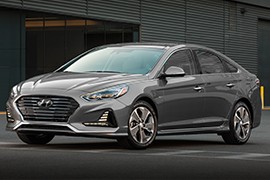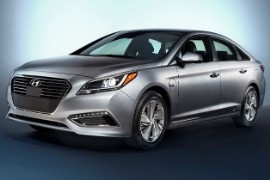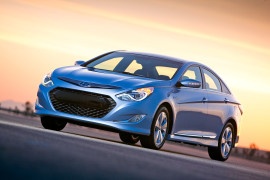HYUNDAI Sonata Hybrid Models/Series Timeline, Specifications & Photos
First production year: 2010
Engines: Hybrid, Hybrid gasoline
The seventh generation of the Sonata charged the market in 2014, and the carmaker promised a hybrid and a plug-in hybrid version, which were introduced later on.
In 2017, the entire Sonata lineup received an update that marked the car's change toward a pre-premium segment. It wasn't the budget-buy bargain anymore, but it was a technologically advanced vehicle enclosed into a refined vehicle.
Its exterior was very similar to the rest of the 2017 Sonata range. The drag coefficient was improved to a class-leading 0.24 Cd, thanks to its fluid lines and sculptured doors and side panels. At the front, the cascade-grille design and the side-scoops were meant to divert the flow and made it ran smoother on the car's surface. In the rear, behind the sloped windscreen, the carmaker installed a profiled trunk lid that prevented turbulences behind the vehicle. Apart from the roof, Hyundai changed every other body panel.
Inside, the carmaker added a few modifications to match the exterior's new look. Its instrument panel design and the three-spoke steering wheel were slightly enhanced, while the piano key buttons for the audio and HVAC controls gave a premium look for the center stack.
For the drivetrain, Hyundai installed a 2.0-liter, direct-injected gasoline engine. It produced 154 hp and a 38 kW electric engine helped it. When combined, the two engines provided 193 hp, which were sent to the front wheels via a six-speed automatic transmission.
The seventh generation of the Sonata was introduced in 2014 and, a year later, the Korean carmaker introduced the plug-in hybrid version at the 2015 North American International Motor Show.
In the quest for offering low-emission vehicles, Hyundai developed a plug-in hybrid system, which was successfully applied on the Sonata. It offered a decent full-electric range for in-city driving and decent overall power to cope well with highway traffic.
The new swept lines made the car look like it had a liquid body, and it was hit with a strong, frontal wind. The raked windshield started the curved line of the greenhouse—the ascending side-line ended-up on the rear taillights. On top of the trunk, a small lip was installed on some versions. In the back, the Sonata PHEV showed no tailpipe under the bumper to improve the image of an environmentally-friendly vehicle.
Inside, there was room for five adults, but the rear mid passenger had to sit on top of a bulky center tunnel even though the car was front-wheel drive and it didn't have an all-wheel-drive version. The instrument cluster was a mix between round dials and a TFT display.
The powertrain offered a 50 kW electric motor and a 2.0-liter gasoline direct-injected engine. Hyundai paired the assembly to a standard 6-speed manual gearbox that sent the power to the front wheels. Its 9.8 kWh battery pack helped the vehicle deliver up to 93 MPG (2.5 l/100 km) fuel-efficiency.
Hyundai introduced the sixth generation of the Sonata in 2009 with ICE-only drivetrains and updated it in 2010 for the 2011 model year with a hybrid version.
With the Sonata lineup, Hyundai made its way up in the mid-size sedan segment in the American market. What started as a mundane vehicle became a sought-after one after major improvements. Moreover, the Korean carmaker didn't slow down the pace even after it introduced the Sonata's sixth generation in 2009 and enhanced it with a modern, hybrid drivetrain in 2010 for the 2011 model year.
With an exterior that showed a fluid design, as a reminiscence of the bio-design era, the sixth Sonata boasted a longer wheelbase that improved not only the interior comfort but also added the necessary space to include the hybrid system components and battery behind the rear seats. Unlike the rest of the range, the Sonata Hybrid sported not only the "Hybrid" nameplate but also the "Blue" one, which was Hyundai's way of telling that the car was green.
Inside, the 2011 Sonata features better-quality materials and a design inspired by upscale, premium sedans. A new center console and instrument panel borrowed some cues from the Hyundai Veracruz. For the infotainment system, a new touch-screen display with navigation was offered as an option, while the standard was a radio-CD-MP3 player with USB and AUX-in jack.
For the drivetrain, the automaker opted for a 2.4-liter inline-four Atkinson cycle engine that was boosted with an electric motor for a total output of 209 hp (212 PS). It was paired with a six-speed automatic gearbox that also allowed for manual gearchanges, although without paddle shifters behind the steering wheel.


